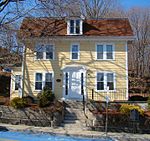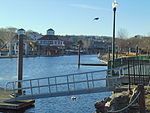Telephone Exchange Building (Norwich, Connecticut)
1906 establishments in ConnecticutBuildings and structures in Norwich, ConnecticutColonial Revival architecture in ConnecticutHistoric district contributing properties in ConnecticutIndustrial buildings and structures on the National Register of Historic Places in Connecticut ... and 5 more
Infrastructure completed in 1906NRHP infobox with nocatNational Register of Historic Places in New London County, ConnecticutTelecommunications buildings on the National Register of Historic PlacesTelephone exchange buildings

The Telephone Exchange Building is a historic building at 23 Union Street in downtown Norwich, Connecticut, behind Norwich Town Hall. Built in 1906-07, it was the first purpose-built telephone exchange building in the city, and is a little-altered example of period exchanges built by the Southern New England Telephone Company. The building now houses city offices. It was listed on the National Register of Historic Places on November 28, 1983.
Excerpt from the Wikipedia article Telephone Exchange Building (Norwich, Connecticut) (License: CC BY-SA 3.0, Authors, Images).Telephone Exchange Building (Norwich, Connecticut)
Union Street, Norwich
Geographical coordinates (GPS) Address Phone number Website Nearby Places Show on map
Geographical coordinates (GPS)
| Latitude | Longitude |
|---|---|
| N 41.526666666667 ° | E -72.076388888889 ° |
Address
City of Norwich Community Development Offices
Union Street 23
06360 Norwich
Connecticut, United States
Open on Google Maps











